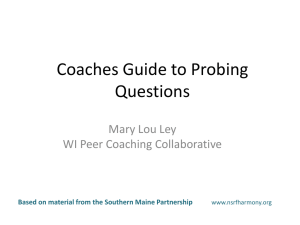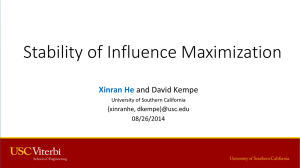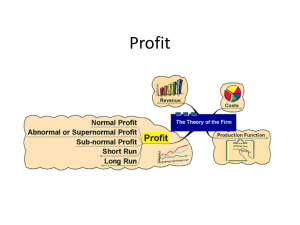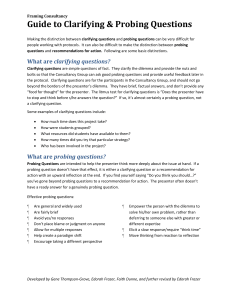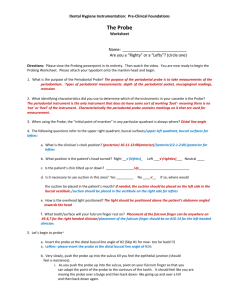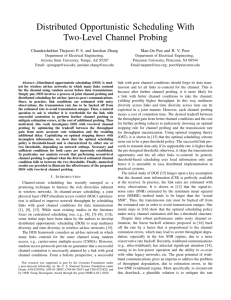Slides - Yihan Sun`s Home
advertisement
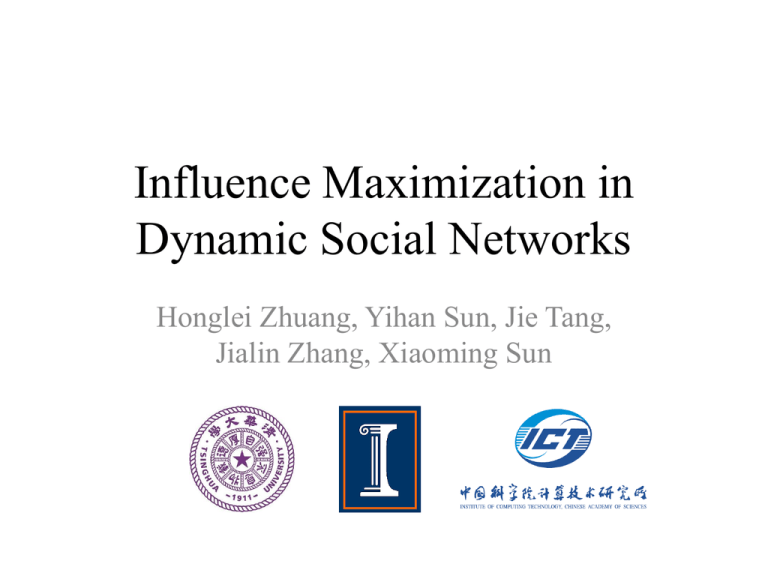
Influence Maximization in
Dynamic Social Networks
Honglei Zhuang, Yihan Sun, Jie Tang,
Jialin Zhang, Xiaoming Sun
Influence Maximization
How to find influential
users to help promote a
new product?
Probability of
influence
0.8
C
B
A
Marketer Alice
0.1
0.5
0.4
0.6
0.1
0.6
D
E
F
0.1
Find K nodes (users) in a social network that could maximize the
spread of influence (Domingos, 01; Richardson, 02; Kempe, 03)
Influence Maximization
• Influence model
– Initially all users are considered inactive
– Then the chosen users are activated, who may
further influence their friends to be active as well
• Models
– Linear Threshold model
– Independent Cascading model
[1] D. Kempe, J. Kleinberg, and E. Tardos. Maximizing the spread of influence through a social network. KDD’03, pages 137–146, 2003.
Approximate Solution
• NP-hard [1]
– Linear Threshold Model
– Independent Cascading Model
The problem is solved by optimizing
a monotonic submodular function
00
• Kempe Prove that approximation algorithms can guarantee that the
influence spread is within(1-1/e) of the optimal influence spread.
– Verify that the two models can outperform the traditional heuristics
• Recent research focuses on the efficiency improvement
– [2] accelerate the influence procedure by up to 700 times
• It is still challenging to extend these methods to large data sets
[1] D. Kempe, J. Kleinberg, and E. Tardos. Maximizing the spread of influence through a social network. KDD’03, pages 137–146, 2003.
[2] J. Leskovec, A. Krause, C. Guestrin, C. Faloutsos, J. VanBriesen, and N. Glance. Cost-effective outbreak detection in networks. KDD’07, pages
420–429, 2007.
Influence Maximization in Dynamic Networks
t =0
Evolve
t =1
Probe
About 6 million links changed on Weibo network
Weibo API limitation: ≤ 450 times/hr
Original edges
Added edges
Removed edges
Problem
• Input: For a dynamic social network {G0,…, Gt}, we
have observed G0, but for all t>0, Gt is unknown
• Problem: To probe b nodes, observe their neighbors to
obtain an observed network Gˆ t from Gˆ t -1 / G 0 , such that
influence maximization on the real network G t can be
approximated by that on the observed network.
• Challenge: How to find the k influential users, if we only
partially observe the update of the social network?
Basic Idea
• Estimate how likely the neighborhood of a
node will change in a dynamic social network
– Probe nodes that change a lot
• Estimate how much the influence spread can
be improved by probing a node
– Probe the one maximizes the improvement
Methodologies and Results
Preliminary Theoretical Analysis
• Formal definition of loss
Max seed set on fully observed network
EG|Gˆ Q S * Q T *
Max seed set on partially observed network
• With an specified evolving graph model
– At each time stamp an edge is chosen uniformly
– and its head will point to a node randomly chosen
with probability proportional to the in-degree
Preliminary Theoretical Analysis
• Error bound of Random probing strategy
• Error bound of Degree weighted probing strategy
• In most cases, degree weighted probing strategy
performs better than random probing strategy
Maximum Gap Probing
• Basic Idea
– Estimate how much the influence spread can be
improved by probing a node
– Probe the one which maximizes the improvement
• Formally,
– For a given tolerance probability
– The minimum value that satisfies the following
inequality is defined as performance gap v
P Qˆ v S 'o v Qˆ v So
Best solution
if v is probed
Best solution
before probing
*To simplify problem, define the quality function as the sum of degree in the seed set.
Maximum Gap Probing
• Assume the degree of a node is a martingale. We can
estimate the degree gap of each node by
P d t v d t cv v 2cv ln
Last time when v is probed Defined as zv
• Considering the node to probe is in/not in the current seed
set.
max 0, dˆ v z min dˆ w , v S
v wS
O
o
v
max 0, max dˆ u dˆ v zv , v SO
uSo
• Each time, choose the one with maximum gap v to
probe
MaxG Algorithm
Finding nodes to probe
by maximizing the
degree gap
Perform the standard
greedy algorithm
(degree discount
heuristics) for
influence maximization
Experiment Setup
• Data sets
Data sets
#Users
#Relationships
#Time stamps
Synthetic
500
12,475
200
Twitter
18,089,810
21,097,569
10
Coauthor
1,629,217
2,623,832
27
• Evaluation
– Take optimal seed set S ' obtained from partially
observed network
– Calculate its influence spread on real network
Experiment Setup
• Comparing methods
– Rand, Enum: Uniform probing
– Deg, DegRR: Degree-weighted probing
– BEST: Suppose network dynamics fully observed
• Configurations
– Probing budget:
• b=1,5 for Synthetic; b=100,500 for Twitter and Coauthor
– Seed set size for influence maximization:
• k=30 for Synthetic; k=100 for Twitter and Coauthor
– Independent Cascade Model, with uniform p=0.01
Experimental Results
• Average influence spread
Data Set
b
Rand
Enum
Deg
DegRR
MaxG
1
13.83
13.55
13.78
14.30
14.79
BEST
15.95
Synthetic
5
15.07
15.33
15.09
15.40
15.60
100
987.74
987.62
988.41
1001.47
1005.12
1011.15
Twitter
500
987.45
987.67
988.36
1006.38
1010.61
100
20.34
20.82
28.67
38.94
45.51
91.51
Coauthor
500
20.35
22.93
44.27
56.68
The large, the best
61.74
Influence Maximization Results (b=100)
Twitter
Coauthor
Influence Maximization Results (b=500)
Twitter
Coauthor
Conclusions
Conclusions
• Propose a probing algorithm to partially
update a dynamic social network, so as to
guarantee the performance of influence
maximization in dynamic social networks
• Future work include:
– Online updating seed set in dynamic social
networks
– Probing for other applications, e.g. PageRank[1]
[1] B. Bahmani, R. Kumar, M. Mahdian, and E. Upfal. PageRank on an evolving graph. In KDD, pages 24–32, 2012.
Thank you
• Dec 8, 2013
•
•
•
•
•
Go to…
Motivating Example
Problem Formulation
Approach
Experiments

